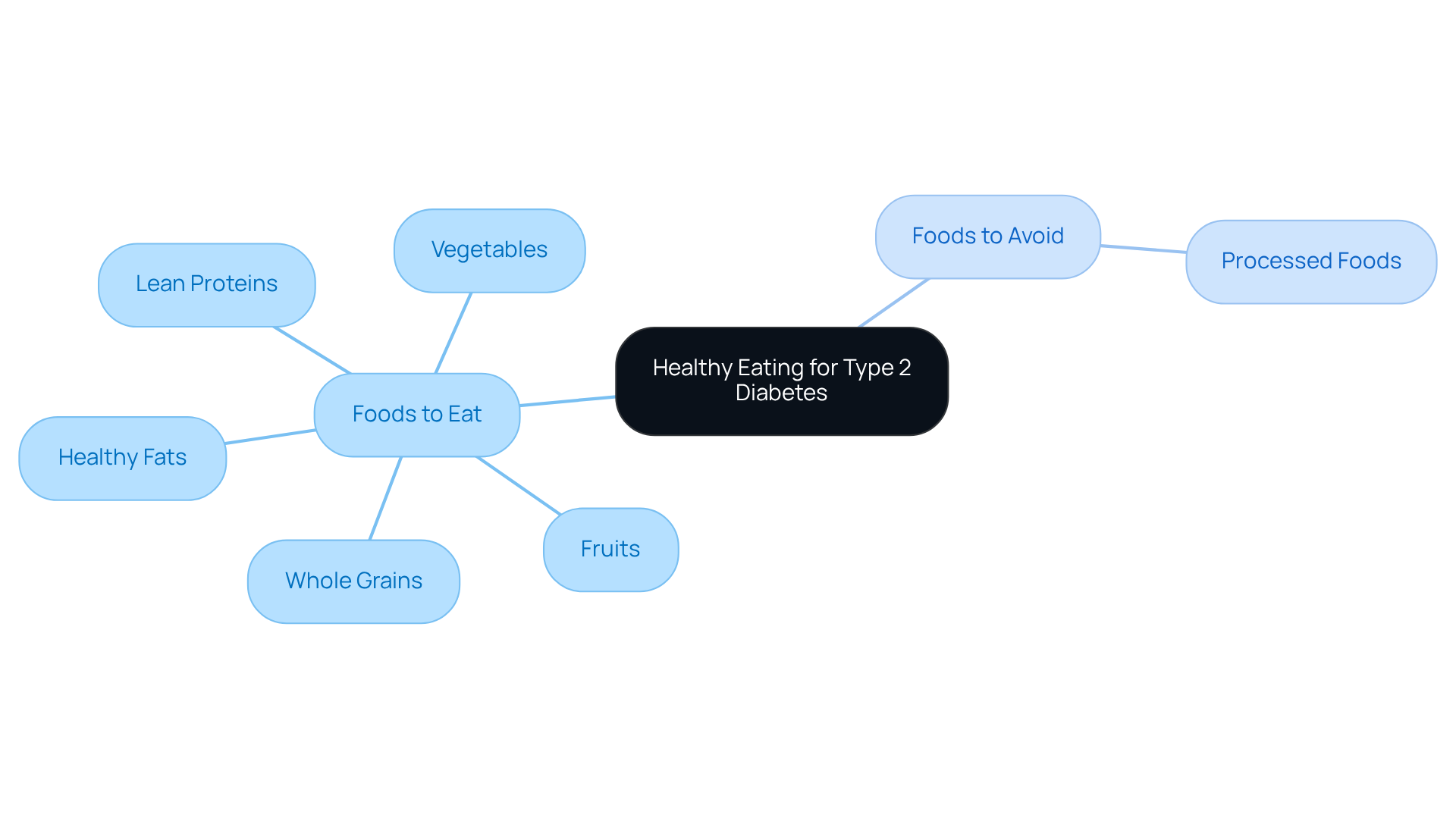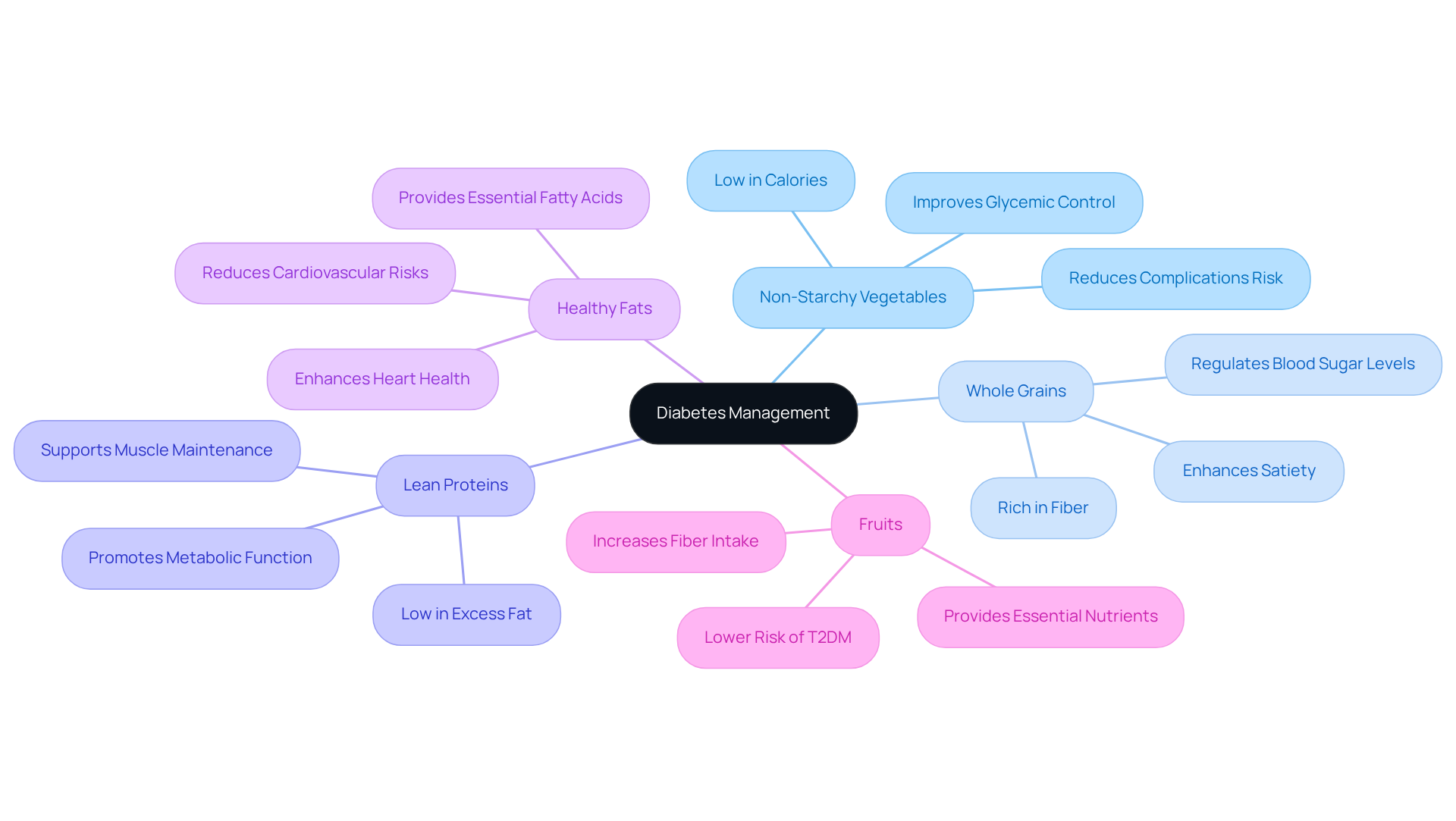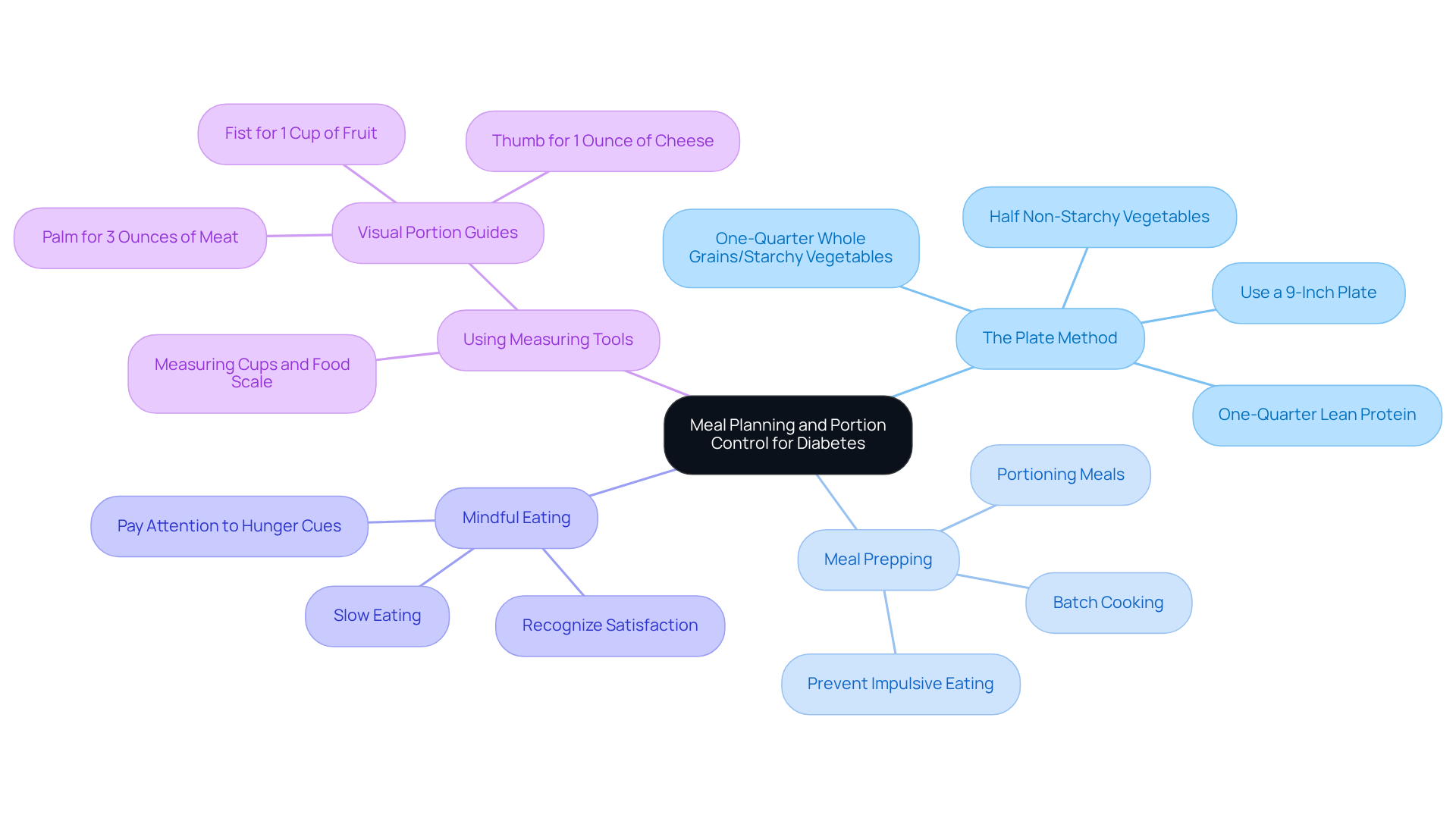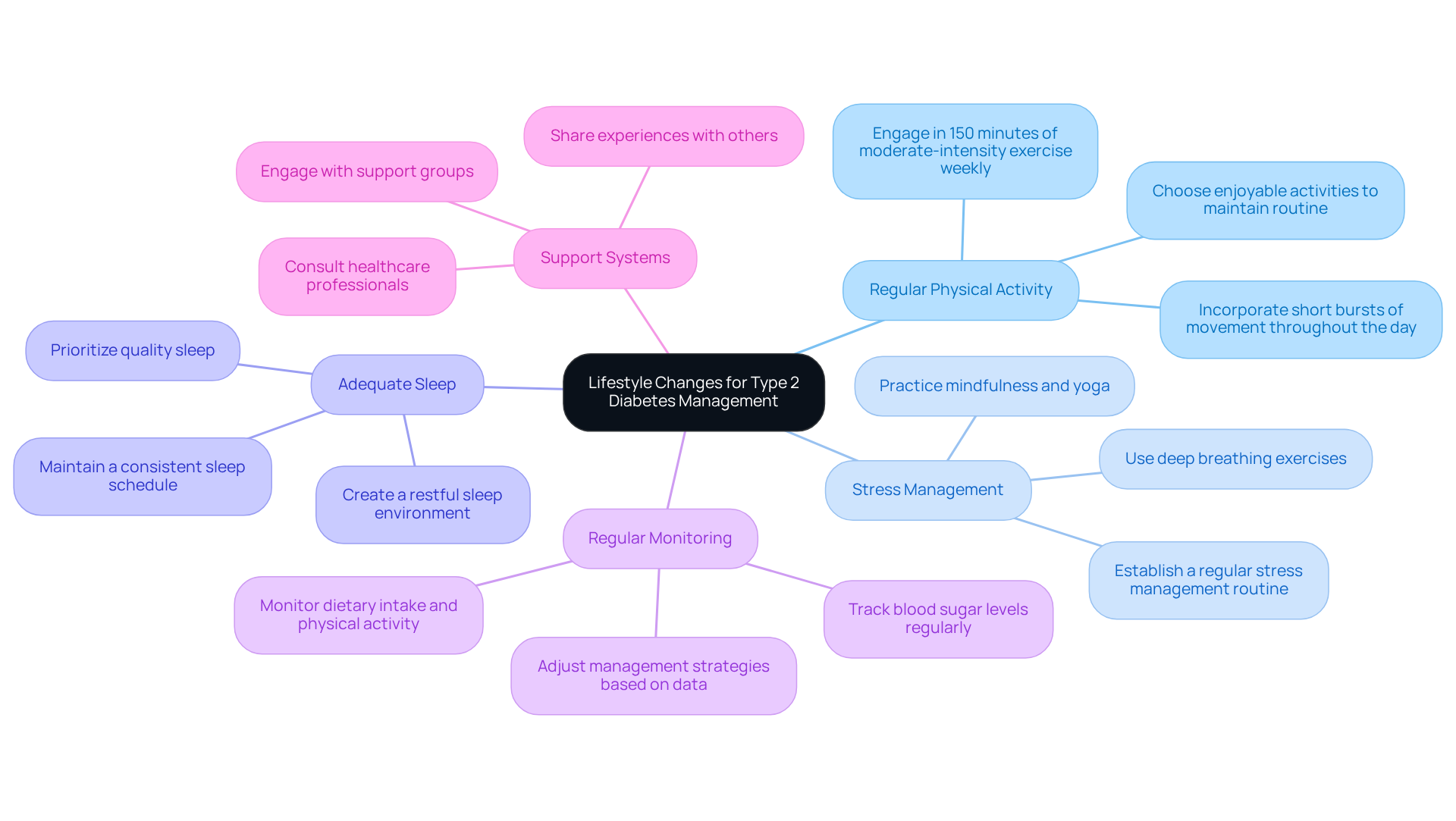Overview
This article highlights essential food groups and meal planning strategies for managing Type 2 diabetes, focusing on the importance of a balanced diet filled with whole foods like fruits, vegetables, whole grains, lean proteins, and healthy fats. It's understandable to feel overwhelmed by dietary changes, but these food choices are crucial. They help regulate glucose levels, promote overall well-being, and prevent diabetes-related complications.
To support you on this journey, practical meal planning techniques are included, such as the Plate Method and mindful eating. These strategies not only enhance dietary adherence but also empower you to make informed choices. Remember, you’re not alone in this journey; we are here to support you every step of the way.
As you explore these options, consider how these changes can positively impact your health and lifestyle. Take small steps, and don’t hesitate to reach out for support or resources that can guide you further. Your health matters, and together, we can navigate this path toward better well-being.
Introduction
Understanding the right foods to consume is a vital aspect of managing Type 2 diabetes effectively. It’s completely understandable to feel overwhelmed by the myriad of dietary choices available. A well-balanced diet not only aids in regulating blood sugar levels but also enhances overall health, making it essential for individuals navigating this condition.
This article aims to shed light on key food groups, meal planning strategies, and lifestyle changes that can empower you to take control of your health. You're not alone in this journey; together, we can explore the best options for informed dietary decisions.
Define Healthy Eating for Type 2 Diabetes
It is essential to know what foods to eat for type 2 diabetes in order to nourish your meals and effectively manage your health. A balanced diet is crucial when considering what foods to eat for type 2 diabetes, as it helps regulate glucose levels while providing vital nutrients. When considering what foods to eat for type 2 diabetes, focus on whole foods like:
- Fruits
- Vegetables
- Whole grains
- Lean proteins
- Healthy fats
At the same time, try to reduce processed foods that are high in sugars and unhealthy fats. This approach focuses on what foods to eat for type 2 diabetes to maintain stable glucose levels, enhance your overall well-being, and prevent complications related to diabetes.
A balanced diet not only supports glucose regulation but also plays a crucial role in weight management and heart health, highlighting what foods to eat for type 2 diabetes, which are especially important for those living with diabetes. You're not alone in this journey; many find it challenging to navigate dietary choices. T2DSolutions is here to help. We provide valuable resources, education, and community support to guide you through your dietary decisions and help you manage your condition effectively.
Remember, it's understandable to feel overwhelmed. By focusing on nourishing meals and seeking support, you can take positive steps toward a healthier future. Together, we can make this journey easier.

Identify Key Food Groups for Diabetes Management
At T2DSolutions, we genuinely care about providing essential resources for managing Type 2 Diabetes. It’s important to know that you’re not alone in this journey. Here are some key food groups that can help you manage your condition:
-
Non-Starchy Vegetables: These should form a substantial part of your meals. Leafy greens, broccoli, and bell peppers are wonderful choices. They are low in calories and carbohydrates, making them ideal for maintaining stable glucose concentrations. Regularly including non-starchy vegetables in your diet is crucial for understanding what foods to eat for type 2 diabetes, as it is associated with improved glycemic control and a reduced risk of diabetes complications.
-
Whole Grains: Foods like brown rice, quinoa, and whole wheat bread are rich in fiber, which aids in regulating blood sugar levels and enhances feelings of fullness. Research shows that whole grains are essential for a diabetes-friendly diet, highlighting what foods to eat for type 2 diabetes, as they are linked to lower glucose and insulin concentrations.
-
Lean Proteins: Incorporating sources such as chicken, turkey, fish, beans, and legumes is essential for muscle maintenance and overall well-being without adding excessive fat. Aim for protein consumption to be approximately 15-25% of your total energy value, as this promotes metabolic function and satiety.
-
Healthy Fats: Including sources like avocados, nuts, and olive oil can enhance heart health and provide essential fatty acids. These fats are beneficial in moderation, as they can help reduce cardiovascular risks associated with diabetes.
-
Fruits: While fruits contain natural sugars, they also provide essential nutrients and fiber. Opting for whole fruits rather than juices increases your fiber intake, which is crucial for managing glucose levels. A diet rich in fruits and vegetables is associated with a lower risk of Type 2 Diabetes, which underscores what foods to eat for type 2 diabetes in order to ensure balanced meal planning.
For more resources and support in managing your diabetes, we invite you to explore what T2DSolutions has to offer. Remember, we are here to support you every step of the way.

Plan Meals and Control Portions Effectively
Managing diabetes can feel overwhelming, but understanding what foods to eat for type 2 diabetes along with effective meal planning and portion control can make a significant difference in your journey. Here are some compassionate strategies to enhance your approach:
-
The Plate Method: Imagine your plate divided into sections: half for non-starchy vegetables, one-quarter for lean protein, and one-quarter for whole grains or starchy vegetables. This method not only streamlines portion management but also guarantees a balanced meal by showing you what foods to eat for type 2 diabetes, helping you regulate your glucose levels more effectively.
-
Meal Prepping: Preparing meals in advance can provide a sense of stability and prevent impulsive eating. By batch cooking and portioning meals into containers, you save time and ensure that healthy options are always within reach. This reduces the temptation to choose less nutritious foods when hunger strikes.
-
Mindful Eating: It's important to encourage slow eating and to pay attention to your hunger cues. This practice can help prevent overeating and foster a healthier relationship with food, allowing you to recognize when you are satisfied rather than eating out of habit.
-
Using Measuring Tools: Consider using measuring cups or a food scale to accurately gauge portion sizes, especially for carbohydrate-rich foods. Understanding portion sizes is crucial, as even minor differences can greatly influence glucose levels. For instance, a helpful guide suggests using the palm of your hand for 3 ounces of meat and a fist for one cup of fruit, making it easier to visualize appropriate portions.
By applying these strategies, you can effectively manage your portions and learn what foods to eat for type 2 diabetes, leading to improved glucose control and overall health. Remember, you are not alone in this journey, and we are here to support you every step of the way.

Incorporate Lifestyle Changes for Comprehensive Management
Incorporating lifestyle changes is essential for comprehensive management of Type 2 Diabetes. You're not alone in this journey, and making these adjustments can significantly enhance your well-being. Here are some key changes to consider:
-
Regular Physical Activity: Engaging in at least 150 minutes of moderate-intensity exercise each week can significantly enhance insulin sensitivity and support weight management. Activities can range from brisk walking to cycling, and even short bursts of movement throughout the day can be beneficial. For instance, interrupting inactive periods with gentle exercise, such as walking during breaks or using the stairs, can positively affect glucose concentrations.
-
Stress Management: It's understandable to feel overwhelmed at times, but chronic stress can negatively impact blood sugar values. Techniques such as mindfulness, yoga, and deep breathing exercises have been shown to effectively manage stress. By consistently participating in these practices, you can stabilize glucose levels and enhance your emotional well-being.
-
Adequate Sleep: Prioritizing quality sleep is crucial. Insufficient rest can disrupt metabolic processes and increase insulin resistance. Establishing a consistent sleep schedule and creating a restful environment can enhance sleep quality, supporting your diabetes management efforts.
-
Regular Monitoring: Keeping track of your blood sugar levels, dietary intake, and physical activity is vital for informed decision-making. Regular monitoring empowers you to adjust your management strategies as needed, ensuring you stay on track with your health goals.
-
Support Systems: Engaging with support groups or healthcare professionals provides encouragement and accountability. Sharing experiences and strategies with others facing similar challenges fosters a sense of community and resilience, which is essential for long-term success. Remember, we are here to support you every step of the way.

Conclusion
Understanding the right foods to eat for type 2 diabetes is crucial for maintaining health and managing glucose levels effectively. A balanced diet centered around whole foods—such as fruits, vegetables, whole grains, lean proteins, and healthy fats—supports glucose regulation and enhances overall well-being. By prioritizing these food groups and minimizing processed options, individuals can take significant steps toward better health management.
It's important to recognize that meal planning and portion control can make a big difference. Strategies like the Plate Method, meal prepping, and mindful eating can simplify dietary choices and promote healthier eating habits. Incorporating lifestyle changes, such as regular physical activity, stress management, and sufficient sleep, empowers individuals to manage their diabetes comprehensively. Remember, engaging with support systems can provide the encouragement and accountability you need on this journey.
Ultimately, adopting these nutritional guidelines and lifestyle modifications is essential for effective diabetes management. By focusing on nourishing meals and making conscious choices, you can improve your health outcomes and enhance your quality of life. Taking these steps not only benefits you but also fosters a supportive community that thrives on shared experiences and knowledge. You're not alone in this journey; we are here to support you every step of the way.
Frequently Asked Questions
What is healthy eating for type 2 diabetes?
Healthy eating for type 2 diabetes involves a balanced diet that helps regulate glucose levels while providing essential nutrients. It focuses on whole foods and minimizes processed foods high in sugars and unhealthy fats.
What types of foods should I include in my diet for type 2 diabetes?
You should include whole foods such as fruits, vegetables, whole grains, lean proteins, and healthy fats in your diet for type 2 diabetes.
Why is a balanced diet important for managing type 2 diabetes?
A balanced diet is crucial for managing type 2 diabetes as it supports glucose regulation, aids in weight management, and promotes heart health, which are all important for those living with diabetes.
What foods should I reduce in my diet if I have type 2 diabetes?
You should reduce processed foods that are high in sugars and unhealthy fats to help maintain stable glucose levels and enhance overall well-being.
How can T2DSolutions assist individuals with type 2 diabetes?
T2DSolutions provides valuable resources, education, and community support to help individuals navigate dietary choices and manage their condition effectively.
Is it normal to feel overwhelmed when making dietary choices for type 2 diabetes?
Yes, it is understandable to feel overwhelmed when navigating dietary choices for type 2 diabetes. Seeking support and focusing on nourishing meals can help in making positive changes.



